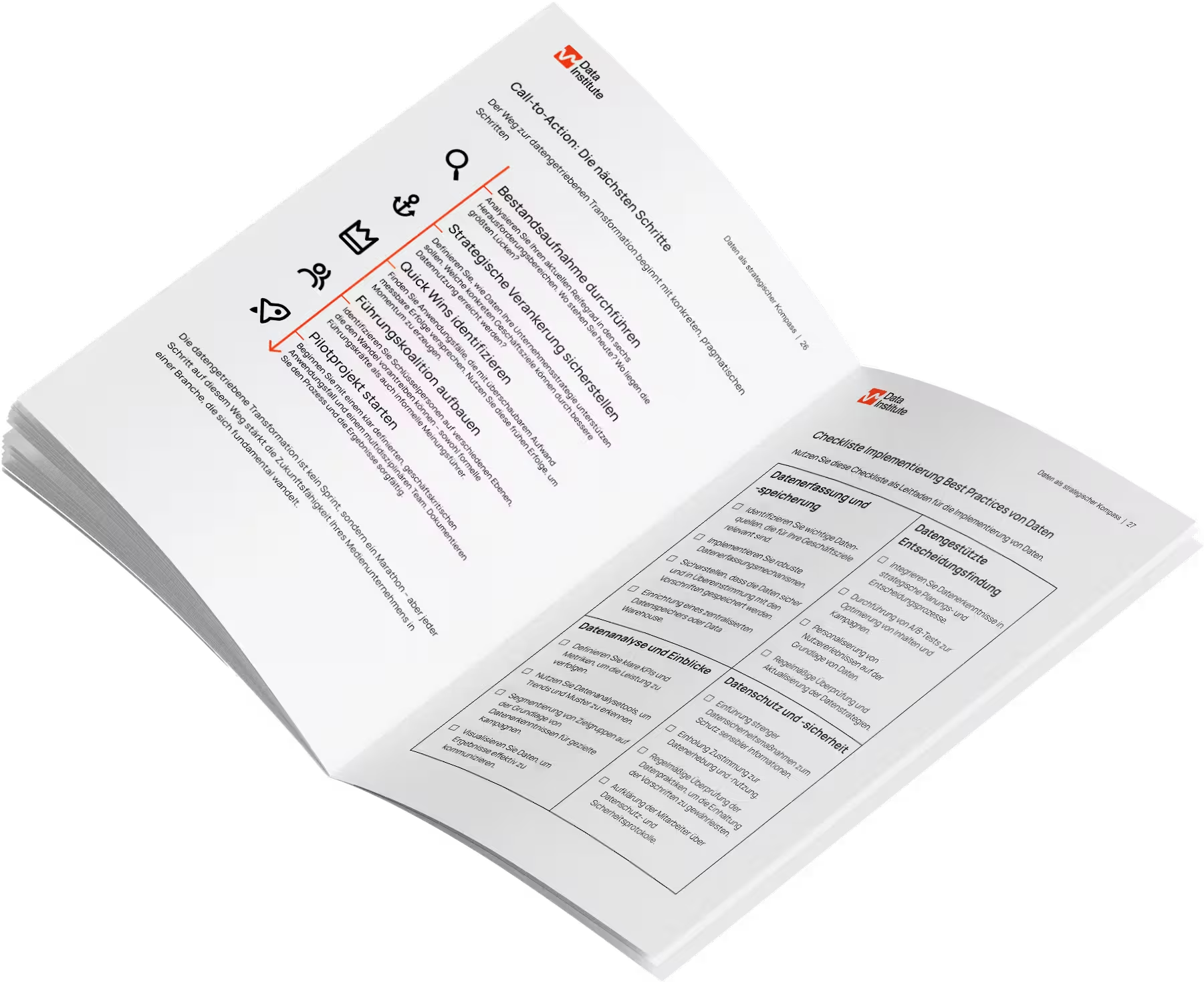Cloud computing for data warehousing and data analytics


The roadmap for data-driven transformation
The ePaper shows you strategies, success stories and a checklist for a direct start into the digital future.

- Das ist eine H2
- Das ist eine H3
The cloud has revolutionized the way companies handle data. For both data enthusiasts and executives, it offers numerous advantages over traditional on-premise solutions.
But what does cloud computing actually mean for data warehousing and data analytics? And what benefits does it offer companies?
Why cloud computing is ideal for data warehousing
The scalability, cost efficiency, and accessibility of cloud solutions make them the perfect choice for modern data warehouses. Companies can flexibly adapt their data infrastructure to growing volumes of data and changing requirements.
1. Scalability and flexibility
- Dynamic scaling: Resources can be adjusted in real time to handle seasonal fluctuations or unexpected peak loads.
- Auto scaling: Automatic scaling based on workload ensures optimal resource utilization and cost control.
- Flexible deployment models: Choose between different deployment models (IaaS, PaaS, SaaS) to best meet the company's needs.
2. Cost efficiency
- Pay per use: Pay only for the resources you actually use, resulting in significant cost savings.
- No high initial investments: Avoid spending heavily on hardware and software.
- Cost transparency: Detailed cost reports allow precise control of expenditure.
3. Global accessibility and collaboration
- Global collaboration: Enable teams from different locations to collaborate in real time.
- Data consistency: Guarantee a uniform database for all parties involved.
- Remote work: Give your employees the ability to access data and perform analyses from anywhere.
4. Safety
- Constant security updates: Benefit from the latest security measures that are continuously provided by cloud providers.
- Compliance: Comply with regulatory and industry standards (such as GDPR, HIPAA) with built-in security features.
- Data loss prevention: Protect your data from loss and unauthorized access.
5. Innovation and agility
- Quick launch: Bring new products and services to market faster.
- Experimenting and prototyping: Enable rapid experimentation and development of new applications.
- Integration of new technologies: Use the latest technologies such as AI, machine learning, and IoT to develop innovative solutions.
6. Data quality
- Central data source: Consolidate your data into a central source to improve data quality and reduce inconsistencies.
- Data cleansing and transformation: Automate data preparation to ensure that data is suitable for analysis.
- Metadata management: Manage metadata effectively to understand the meaning and context of data
7. Performance and scalability
- High-performance infrastructure: Use the powerful infrastructure of cloud providers for sophisticated analysis tasks.
- In-memory computing: Speed up your analytics with in-memory data processing
- Real-Time Analytics: Make faster, data-based decisions.
8. Sustainability
- Reducing the carbon footprint: Take advantage of the energy efficiency of cloud data centers.
- Sustainable use of resources: Contribute to a sustainable IT infrastructure
9. Integration
- Seamless integration: Seamlessly integrate your cloud-based data warehouses into your existing IT landscapes.
- Open standards: Use open standards and APIs for flexible integration.
10. Expert assistance
- 24/7 support: Benefit from comprehensive support from cloud providers.
- Managed services: Transfer the operation of your data warehouse environment to experts.
Specific application examples from practice
- E-commerce: Personalized product recommendations, real-time inventory monitoring, and predictive analytics to optimize marketing campaigns
- Finance: Fraud detection, risk management and customer analysis for tailored financial products
- Manufacture: Predictive maintenance, IoT integration, supply chain management
- Healthcare Health: patient management, clinical trials and research, as well as the development of new drugs
- Education: online learning, virtual classrooms, data analysis for educational research
- Public sector: e-government services, citizen participation, smart cities
Cloud computing in e-commerce
The cloud is revolutionizing e-commerce processes. Real-time inventory monitoring optimizes supply chains and minimizes outages. Predictive analytics enables accurate forecasting of customer demand so that marketing budgets can be used more efficiently. Personalized product recommendations increase the conversion rate and thus contribute to higher sales. The cloud offers the necessary flexibility and scalability to meet the growing demands of e-commerce. Other use cases include personalized product recommendations, real-time inventory monitoring and predictive analytics to optimize marketing campaigns.
Cloud computing in finance
Cloud-based solutions in finance rely on powerful technologies such as machine learning and artificial intelligence. These make it possible to analyze complex amounts of data in real time and to recognize patterns that are barely visible to human analysts. By using cloud infrastructures, financial institutions can reduce their IT costs while benefiting from a high level of scalability. This is particularly important to meet the increasing demands of the digital world. Other uses include fraud detection, risk management and customer analysis for tailor-made financial products.
Cloud computing in healthcare
In healthcare, the cloud is revolutionizing patient care. Centralized storage of patient data in the cloud enables efficient patient management. Doctors and nurses can access relevant information anytime, anywhere. In addition, the cloud accelerates clinical trials and research processes by facilitating collaboration between scientists worldwide and providing access to large amounts of data. This leads to faster development of new drugs and treatment methods. Applications can include patient management, clinical trials and research, as well as the development of new drugs.
Cloud computing in manufacturing
The cloud supports manufacturing in producing high-quality products. By analyzing large amounts of data, quality problems can be identified and resolved at an early stage. The flexible scalability of the cloud makes it possible to react quickly to fluctuating production volumes. In addition, the cloud facilitates collaboration between different locations and suppliers, which leads to higher product quality and shorter development cycles. Other options for using cloud computing include predictive maintenance, IoT integration or supply chain management.
Cloud computing in education
The cloud has revolutionized education, and not just since Corona. Online learning and virtual classrooms make education location-independent and flexible. Students can access teaching materials from anywhere and at any time. The cloud provides a personalized learning environment in which every student can learn at their own pace. In addition, the cloud makes data analysis for educational research easier, which allows new insights into learning processes to be gained. Areas of application include online learning, virtual classrooms or even data analysis for educational research.
Cloud computing in the public sector
In the public sector, the cloud enables efficient delivery of e-government services. Citizens can access official services and submit applications from the comfort of their own home. By using cloud-based platforms, processes can be automated and accelerated, resulting in significant time and cost savings. In addition, the cloud promotes citizen participation by providing platforms for participating in political decisions. Other areas that can benefit from cloud computing include e-government services, citizen participation or smart cities.
Integrate with other technologies
Cloud-based data warehouses form the basis for innovative technologies such as:
- Big data: Process massive amounts of data with Hadoop and Spark.
- AI and machine learning: Develop intelligent applications for predictive analytics and automated decision making.
- IoT: Use data from the Internet of Things for new business models.
Challenges and solutions
Moving to the cloud also poses some challenges, which we would be happy to list and discuss with you. We help you overcome these hurdles and offer tailor-made solutions to meet your individual requirements.
- Cost management: The costs of cloud services can rise quickly if they are not managed carefully. A meaningful and balanced data infrastructure and data governance are important here.
- Integration of existing systems: Integrating cloud solutions into existing IT landscapes can be complex.
- Staff qualification: It takes trained personnel to effectively manage and use cloud environments.
- Compliance: Compliance with legal regulations and industry standards is particularly important in the cloud environment.
- Vendor lock-in: Dependency on a specific cloud provider may result in restrictions.
Specification of solutions to the challenges
There are solutions to the challenges mentioned above. We have already gained a lot of experience with our customers and partners on the above points and are very happy to discuss them together.
- Data quality: How do you ensure data quality in the cloud? (e.g. through data cleansing, validation and profiling)
- Governance: What governance models do you use to manage and control cloud usage? (e.g. cloud governance board, guidelines, processes)
- Safety: What security measures are you taking to protect data in the cloud? (e.g. encryption, access control, threat management)
- Cost management: How do you help your customers optimize their cloud costs? (e.g. through cost analysis, right sizing, spot instances)
- integration: Which integration approaches do you use to integrate cloud solutions into existing systems? (e.g. APIs, middleware, cloud-native integration platforms)
- Staff qualification: What training offerings do you offer to help your customers train their employees? (e.g. workshops, certification programs)
Our expertise for your success
We already have many years of experience in implementing cloud-based data warehouses. We support you from planning to implementation and ensure smooth integration into your existing IT landscape. Feel free to have a look at our Case studies or our performances past.
Contact us today and let's turn your data into valuable insights together!

Latest news and case studies about data?
Just follow our LinkedIn profile.
Latest news and case studies about data?
Just follow our LinkedIn profile.

Latest news and case studies about data?
Just follow our LinkedIn profile.

Related case studies
There are suitable case studies on this topic

Stay up to date
And subscribe to our newsletter.
Stay up to date
And subscribe to our newsletter.

Stay up to date
And subscribe to our newsletter.



